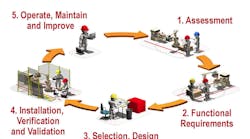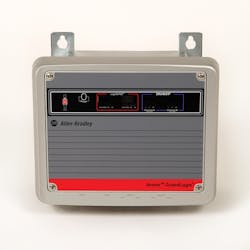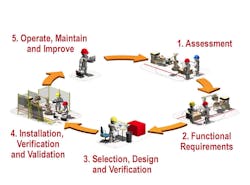Intrepid manufacturers today embrace the idea that safety systems can deliver operational and financial benefits beyond their core safety functionalities.
Consider the introduction of integrated safety, in which standard and safety control are combined into a single programmable controller. The advancement from hard-wired, relay-based safety systems to this single-system platform is helping manufacturers boost overall equipment effectiveness, reduce hardware requirements, simplify programming, and streamline costs.
The ability to access, log, and analyze safety data, for example, enables manufacturers to better understand safety-related downtime events and make improvements to help keep lines running longer. Likewise, distributed I/O modules used as part of an integrated-safety approach help maintenance technicians pinpoint safety-system issues to quickly locate, diagnose, and resolve issues.
Now, manufacturers are using another innovative control-design approach using decentralized technology to capture additional value from their safety systems.
A Decentralized Approach
Driven by improved environmental ratings, plug-and-play connectivity, on-board diagnostics, and modular wiring connections, a decentralized approach involves placing industrial automation controls and hardware closer to an application or onto a machine rather than housing them in a remote cabinet.
During the design process for a centralized approach, machine builders traditionally require significant wiring and labor to connect machines with control cabinets. Using pre-tested wiring assemblies and placing components on the machine can help reduce these costs and improve the machine builder’s time-to-market. In fact, assembly costs for machines that use decentralized technology can be up to 30% lower than conventional methods, according to a study conducted by a consortium of European manufacturers and technology groups. In some instances, the decentralized approach reduced installation time as much as 50%.
Nick Mercorella, a plant engineer at Continental P.E.T. Technologies Inc., experienced these ease-of-installation benefits firsthand. “We were able to install our entire system without ever screwing a wire down,” he says, “thus avoiding any potential miswiring and the system debugging cost associated with such problems.”
In the long term, manufacturers can use decentralized technology to help simplify troubleshooting and reduce their mean time to repair (MTTR). For example, a maintenance technician can more easily isolate problems because the cables for power and networks are from the controller on the machine, rather than intertwined with other cables from a whole production line inside a large control panel. This can lead to locating and replacing an I/O faster.
Pre-manufactured quick-disconnect cabling can help reduce wiring errors while less wiring overall can result in fewer points of failure. Quick-disconnect cabling also offers greater design flexibility to accommodate future component change-outs or system expansions.
Typically, embedded dc power with a pass-through capability enables power from a controller to other devices or modules located on a machine, which can remove the need to provide a power supply for each device and help simplify the overall system architecture.
Additionally, moving hardware onto a machine can help reduce cabinet-space demands by as much as 75% to free up valuable plant-floor real estate.
Decentralized Safety Technology
Moving safety components onto a machine extends the benefits of using decentralized technology to your safety system. Decentralized safety I/O modules can offer the advantages of traditional distributed I/O for both standard and safety control while minimizing the need for electrical boxes and simplifying cable installation. This can help reduce wiring time, startup costs, and overall system footprint compared to traditional systems.
Design Impacts
A machine’s safety components can deliver the same performance and functionality whether they are located in a cabinet or on the machine. As a result, safety-rated decentralized components can offer the same level of compliance with today’s most stringent safety standards as cabinet-based components.
One point of differentiation that machine builders must take into consideration, however, is the decentralized components’ environmental ratings. Because they are located outside a protected cabinet enclosure and exposed to harsh plant-floor conditions, only components with the proper environmental ratings for factors such as temperature, humidity, shock, vibration, and ingress protection should be specified for deployment of decentralized technology.
With this in mind, decentralized safety technology can easily be incorporated into your larger safety-design scheme. Following a functional safety life-cycle approach to systematically assess and mitigate a machine’s risks.
This life cycle, as defined in standards IEC 61508, IEC 62061, and ISO 13849, helps guide engineers to implement safety into a machine in the earliest stages of the design process, rather than recycling past safety designs or adding safety onto a machine after the design is already set. It involves five steps, as follows:
- Perform a hazard or risk assessment—Identify hazards and estimate the associated risk.
- Determine the functional-safety system requirements—Evaluate safeguarding options based on industry acceptable solutions and select mitigation techniques
- Design and verify the system—Design the system architecture, document safety circuit design and procure materials
- Install and validate the system—Verify systems are operating within defined parameters and applicable standards have been satisfied.
- Maintain and improve the system—Verify that system requirements operate within specified parameters for production, safety preventative maintenance and system upgrades.
During this process, it’s important to identify and evaluate any impacts a safety system might have on a machine’s design and functionality. Safety components can increase a machine’s overall design complexity, and have a range of effects on human-machine interactions—from day-to-day machine operation to setup, maintenance, cleaning, and safety-related downtime events.
Understanding this unique interplay can help identify the specific opportunities where decentralized safety technology can create value on machines. Removing the need for safety I/O panels and reducing wiring requirements, for example, will help reduce system complexity and maintenance demands.
The Growing Need for Simplicity
The benefits of moving safety controls and components closer to the machine improve a machine builder’s time-to-market, or for manufacturing end users that want simpler machines that are easier to install, maintain and upgrade.


